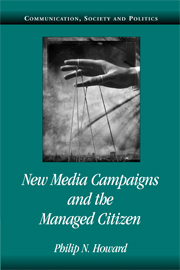Book contents
- Frontmatter
- Contents
- List of Tables and Figures
- Acknowledgments
- Prologue: The Flows of Information in Competitive Politics
- Introduction: The Hypermedia Campaign
- 1 Political Communication and Information Technology
- 2 Producing the Hypermedia Campaign
- 3 Learning Politics from the Hypermedia Campaign
- 4 Organizational Communication in the Hypermedia Campaign
- 5 Managed Citizenship and Information Technology
- Appendix: Method Notes on Studying Information Technology and Political Communication
- Glossary
- References
- Index
- Titles in the series
1 - Political Communication and Information Technology
Published online by Cambridge University Press: 15 December 2009
- Frontmatter
- Contents
- List of Tables and Figures
- Acknowledgments
- Prologue: The Flows of Information in Competitive Politics
- Introduction: The Hypermedia Campaign
- 1 Political Communication and Information Technology
- 2 Producing the Hypermedia Campaign
- 3 Learning Politics from the Hypermedia Campaign
- 4 Organizational Communication in the Hypermedia Campaign
- 5 Managed Citizenship and Information Technology
- Appendix: Method Notes on Studying Information Technology and Political Communication
- Glossary
- References
- Index
- Titles in the series
Summary
How does the culture of competitive political campaigning influence the design of new information technologies, and how do such technologies shape systems of political communication? In the Introduction, I surveyed the evidence about how the sources of political information and means of political engagement have changed over the last decade. I described the ways communication technologies have been used to produce and consume political content, referring variously to news, Web sites, e-mail, and other formats for political information. In this chapter I argue that these hypermedia are components of a new system of political communication formed around online petitions, digital news sources, candidate Web sites, relational databases, and more. I review some of the different ways of studying the role of technology in politics. I make a theoretical argument for moving beyond media effects to a more balanced approach that considers the role of campaign managers and technology engineers in both the production and consumption of political content. I introduce this community of designers and end the chapter with a discussion of how they frame their own work as brokers of information between campaigns and citizens.
Political culture includes more than abstract values and ideologies. Political culture is also defined by the material aspects of information technologies which provide very concrete schema that pattern our values and ideologies and, consequently, our voting behavior and public policy opinions.
- Type
- Chapter
- Information
- New Media Campaigns and the Managed Citizen , pp. 33 - 72Publisher: Cambridge University PressPrint publication year: 2005

